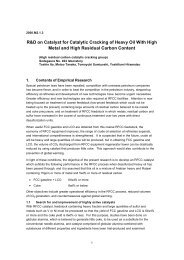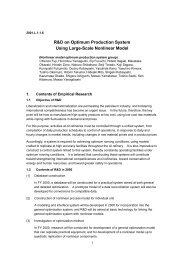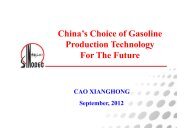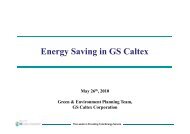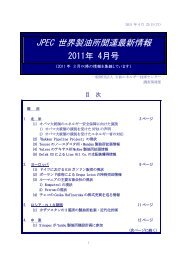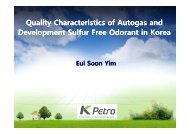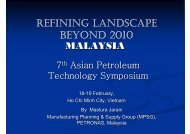R&D on Hydrogen Production by Autothermal Reforming
R&D on Hydrogen Production by Autothermal Reforming
R&D on Hydrogen Production by Autothermal Reforming
Create successful ePaper yourself
Turn your PDF publications into a flip-book with our unique Google optimized e-Paper software.
The gas obtained was analyzed using TCD or FID gas chromatogram; an oxygen combusti<strong>on</strong><br />
type carb<strong>on</strong> analyzer was used to analyze the volume of carb<strong>on</strong> accumulated <strong>on</strong> catalyst after<br />
the reacti<strong>on</strong>.<br />
3.3.2 <strong>Autothermal</strong> <strong>Reforming</strong> Reacti<strong>on</strong> with Each Type of Catalyst<br />
Figure 3.3.1 presents the results of a comparis<strong>on</strong> of the dependency <strong>on</strong> reacti<strong>on</strong> temperature of<br />
autothermal reforming reacti<strong>on</strong> activity with each type of catalyst. The catalysts can be arranged<br />
in sequence as follows.<br />
Catalyst B > Catalyst C > Catalyst A (standard) > Catalyst D > Catalyst E<br />
At 750°C or above, a CO + CO2 selecti<strong>on</strong> rate of virtually 100% was exhibited with all the<br />
catalysts.<br />
The temperature distributi<strong>on</strong> of each catalytic layer at this time is shown in Figure 3.3.2, with<br />
600°C taken as sample reacti<strong>on</strong> temperature. With all the catalysts, it was c<strong>on</strong>firmed that the<br />
temperature rises sharply near the inlet and declines as you go to the lower layers. Dissanayake<br />
et al. 1) and Groote et al. 2) report that in autothermal reforming reacti<strong>on</strong> with methane, a complete<br />
oxidati<strong>on</strong> reacti<strong>on</strong> of methane takes place first, followed <strong>by</strong> water vapor reforming, CO2<br />
reforming, and aqueous gas shift reacti<strong>on</strong>. It is believed that in the latest results as well,<br />
oxidati<strong>on</strong> reacti<strong>on</strong> advanced over the upper catalyst layer. When the catalysts are arranged in<br />
order of highest temperature at the catalyst layer inlet, the following sequence obtains.<br />
Catalyst E > Catalyst D > Catalyst C > Catalyst A (standard) > Catalyst B<br />
This sequence manifests a trend virtually opposite that of the activity sequence. It shows that<br />
when the catalyst inlet temperature is high (that is when the heat given off is great), the<br />
complete oxidati<strong>on</strong> reacti<strong>on</strong> takes precedence over the reforming reacti<strong>on</strong> (steam reforming<br />
reacti<strong>on</strong> or CO2 reforming reacti<strong>on</strong>). In catalyst with low autothermal reforming activity, the<br />
reforming reacti<strong>on</strong> tends to advance less easily than the complete oxidati<strong>on</strong> reacti<strong>on</strong>.<br />
C<strong>on</strong>versely, in catalyst with high autothermal reforming activity, the complete oxidati<strong>on</strong> reacti<strong>on</strong><br />
and reforming reacti<strong>on</strong> both advance easily. The fact that the complete oxidati<strong>on</strong> reacti<strong>on</strong> and<br />
reforming reacti<strong>on</strong> take place at near<strong>by</strong> locati<strong>on</strong>s <strong>on</strong> the catalyst suggests that the temperature<br />
at catalyst inlet is kept relatively low. With catalyst A (standard) and catalyst C, however, this<br />
trend is reversed, and the factors determining catalyst layer temperature distributi<strong>on</strong> are not just<br />
the catalyst’s complete oxidati<strong>on</strong> activity or reforming activity. Such things as thermal<br />
c<strong>on</strong>ductivity and filling density are also c<strong>on</strong>tributing factors.<br />
In the development of autothermal reforming catalyst, it is not <strong>on</strong>ly high activity that is important<br />
but also curtailment of carb<strong>on</strong> precipitati<strong>on</strong>. Of the catalysts c<strong>on</strong>sidered in Figure 3.3.1, ATR<br />
catalyst A and ATR catalysts B and C, which manifest higher activity than ATR catalyst A, were<br />
used in reacti<strong>on</strong>s that took place for 16 hrs at 600°C and the volumes of precipitated carb<strong>on</strong><br />
thereafter were compared as shown in<br />
8




